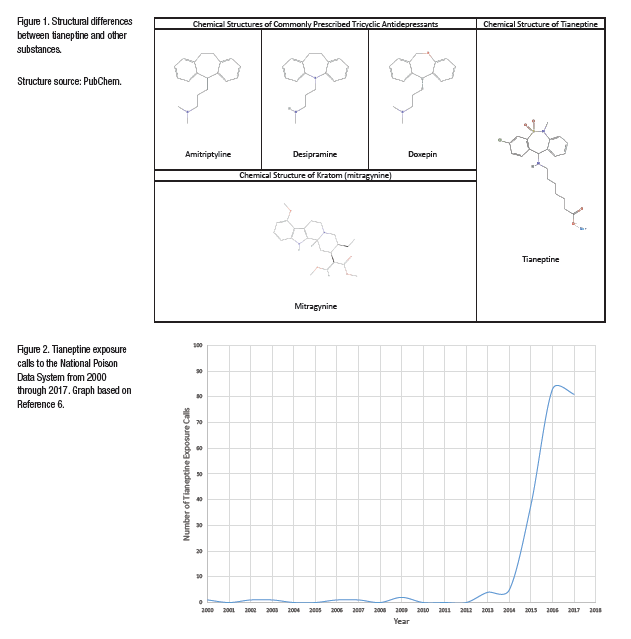Clinicians should be aware of this easily purchased tricyclic-like antidepressant and its opioid-like risks.
By Jeffrey J. Bettinger, PharmD and Jacqueline Cleary, PharmD, BCACP
Pages 61-64
As pain management clinical pharmacists working with an interdisciplinary pain team, it is not uncommon to find patients using and abusing various substances not prescribed to them. What is relatively rare is when a patient reports using a substance of which the team is unfamiliar. Tianeptine is one such substance that has been brought up by both clinic staff and patients as of late. After further research, the authors’ team quickly realized that tianeptine use is growing as a potential new trend within the illicit substance use community. This review therefore aims to dig into the pharmacology of tianeptine – chemically similar to antidepressant agents – and its potential risk for abuse, misuse, and diversion.

 Tianeptine use is growing as a potential new trend within the illicit substance use community. Its pharmacology is chemically similar to antidepressant agents, and brings with it the potential risk for abuse, misuse, and diversion. (Image: iStock)
Tianeptine use is growing as a potential new trend within the illicit substance use community. Its pharmacology is chemically similar to antidepressant agents, and brings with it the potential risk for abuse, misuse, and diversion. (Image: iStock)
Pharmacology
Tianeptine was first discovered more than 30 years ago as a tricyclic-like antidepressant and has since been approved in several European, Asian, and Latin American countries (marketed under Stablon, Coaxil, and Tatinol) for treatment of depression and anxiety.1 Although tianeptine is not currently FDA-approved in the United States, the substance is readily available through online purchase as a dietary supplement or research chemical.
Despite its tricyclic chemical structural similarity (see Figure 1) to tricyclic antidepressants and similar evidence for effectively treating depression, studies have shown that it does not directly modulate monoamine axes or transporters at the neuronal level.1,2 This pharmacology is vastly different than most antidepressants (including tricyclic antidepressants) currently approved in the US for depression and other mood disorders.
Instead, tianeptine has been shown to modulate the glutamatergic system via indirect actions on N-methyl-D-aspartate (NMDA) and alpha-amino-3-hydroxy-5-methyl-4-isoxazolepropionic acid (AMPA) receptors, protect against stress-induced neuronal remodeling and restore neuronal metabolism and function in hippocampus pyramidal neurons and amygdala neurons, and fully agonize both mu- and delta-opioid receptors.1-4
Interestingly, more recent research by Samuels and colleagues in mice has suggested that all of the behavioral-inducing characteristics of tianeptine (acute and chronic antidepressant, hypophagic, analgesic, and hyperactive effects) are dependent upon its ability to activate mu-opioid receptors.5 It was additionally noted that tianeptine effects on mu-opioid receptors in mice did not produce tolerance or withdrawal, further implicating potential downstream signaling effects at the cellular level of tianeptine; although there have been human reports of withdrawal.5 These unique mechanisms, particularly its ability to agonize mu- and delta-opioid receptors, make it a compound of interest regarding its potential in treating mood disorders, but also as a substance that could be easily abused.
Evidence of Rising Abuse
There has been evidence of increasing rates of tianeptine abuse over the past two decades. In 2018, the CDC published data it compiled on tianeptine exposures reported to the National Poison Data System in the United States from 2000 through 2017 (see Figure 2).6 Importantly, only exposure calls related to intentional abuse/misuse of tianeptine were included in the assessment; drug information calls were excluded.6 Throughout the first 14 years of the study, from 2000 through 2013, there was a total of 11 tianeptine exposure calls. However, during the last 3 years, from 2014 through 2017, the total number of tianeptine exposure calls increased to 207 calls representing a statistically significant increase by over 1700%.6 Interestingly, this could be a reaction by legitimate pain patients seeking opioid alternatives due to the current environment which has made it difficult for many patients to obtain their usual opioid prescriptions, however there is yet to be data to support this claim.
This exposure data coincides with other case reviews and analyses reporting rising rates of tianeptine abuse and dependence in a myriad of psychiatric patients.7 The statistics also align with tianeptine policy changes made by several countries outside of the US, including the substance being withdrawn completely from the Georgian market in June 2010, and it being reclassified as a controlled substance in Russia, Armenia, and Ukraine in 2010 and 2011.6
More recently, in 2018, Michigan became the first and currently only state within the United States to officially classify tianeptine as a controlled substance (Schedule II).8 In May 2019, the US DEA’s Diversion Control Division published a report on tianeptine based on the CDC study noted above.9
Toxicity
The danger with un-regulated use of tianeptine is the potential for toxicity in part due to inconsistent purity and potency, especially given its ability to agonize opioid receptors amongst other unknown effects. There have been several case reports and case reviews published highlighting the dangerous and opioid-like toxicity profile of tianeptine.7,10-12 One case series identified 18 patients taking an average daily dose of tianeptine of 1469 mg/day (~110-fold higher than therapeutic doses) exhibiting marked euphoria and withdrawal, which then precipitated additional drug abuse.7 Two additional case reports revealed patients becoming unresponsive after intravenous injection of tianeptine, both of whom were completely reversed and stabilized by naloxone infusions.10,12 Finally, in 2018 a report of two cases was published that identified two patient fatalities from use of tianeptine alone, as no other substances were found in either patient’s serum.11
Besides the above opioid-risks that tianeptine may exhibit, the most commonly reported clinical effects from tianeptine-only exposure found by the CDC from 2000 to 2017 included neurological (48.3%), cardiovascular (32.5%), and gastrointestinal (10.5%).6 The potential harm of this substance by itself, let alone combined with other centrally acting agents, is extremely concerning especially in light of only one state in the US that currently has relative safeguards against its use.
Awareness of this substance, its pharmacology, potential for toxicity, and its apparent ability to be reversed by naloxone are essential to maintain safety when managing patients who may be using or abusing this product.
Drug Monitoring
Returning to the real and increasing possibility that patients may present to clinic reporting use of tianeptine, one question that should be posed by any team of affected clinicians is, how to monitor for abuse of this substance? Unfortunately, there is no immunoassay currently available for in-office point of care testing that allows for identification of this substance in the urine.
Further, after reaching out to several large national lab testing companies, it does not appear that there are any urine assays, screens, or confirmatory tests that specifically assess for tianeptine use. At the time of this writing, only a blood assay is available that allows for the detection of tianeptine; this sampling method is typically more expensive than urine testing, more invasive (particularly for weekly monitoring), and more difficult to obtain from those with a history of substance abuse. Perhaps with the growing use of tianeptine, regulatory authorities and laboratories will develop a urine assay to improve detection.
Discussion
The ambiguity surrounding tianeptine’s regulatory status, increasing rates of abuse, and potential for toxicity certainly echo the early public health concerns related to increasing kratom (mitragynine) use over the early part of the 2010s. From a chemical perspective, the two substances are rather unique. However, from a pharmacological perspective, there are many similarities, as the active components of kratom, mitragynine, and 7-hydroxymitragynine, are partial-agonists of mu-opioid receptors, antagonists at kappa- and delta-opioid receptors, and modulate adrenergic, serotonergic, and dopaminergic receptors.13 While a more thorough comparison between the two compounds is needed, the fact that both have multiple central mechanisms of actions (eg, actions on opioid receptors) is concerning from an overall health perspective, as well as a drug-drug interaction perspective.
Despite not being US FDA-approved for any indication, abuse rates of tianeptine appear to be on the rise, and while they are not yet to the magnitude of other unique substances like kratom, clinicians need to know this is an emerging public health risk. Awareness of this substance, its pharmacology, potential for toxicity, and its apparent ability to be reversed by naloxone are essential to maintain safety when managing patients who may be using or abusing this product.
Continue Reading:
Editorial: From Just Say No, to Say Now and Say Know
